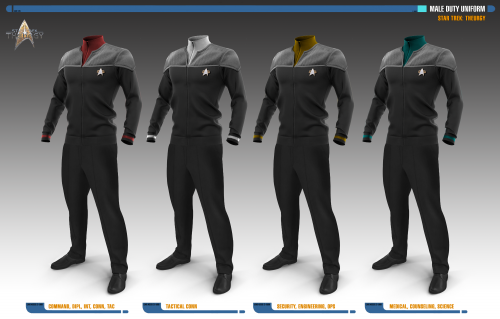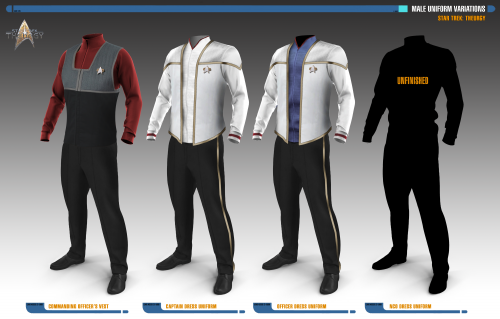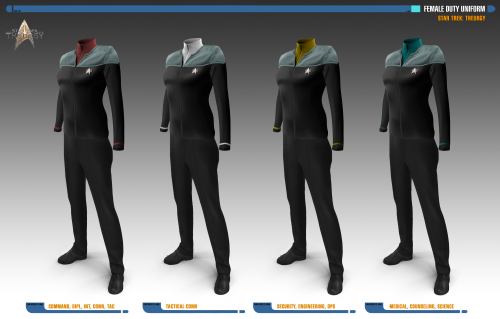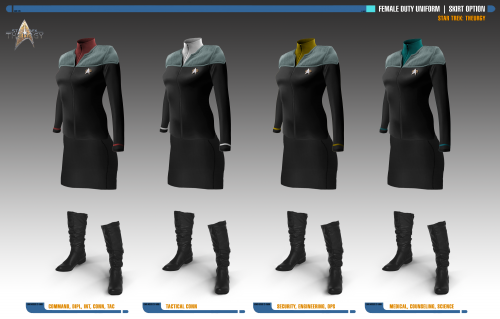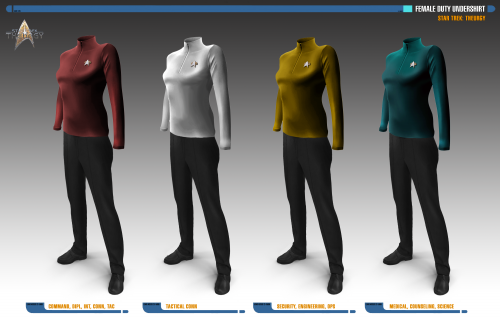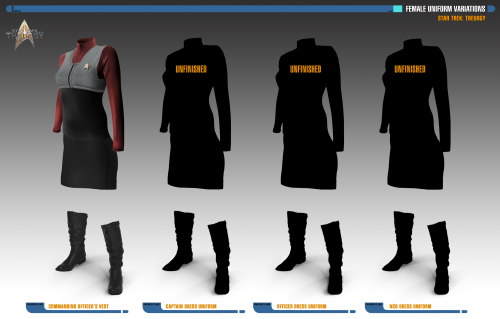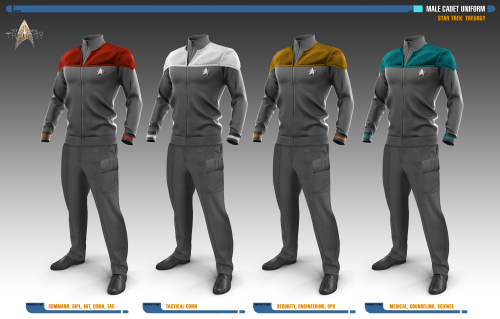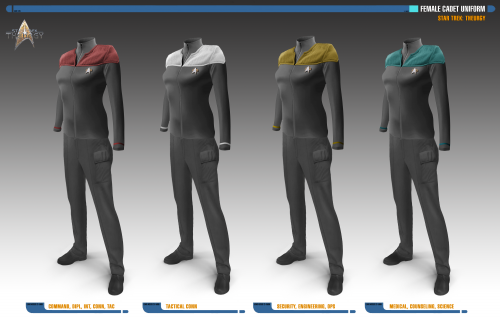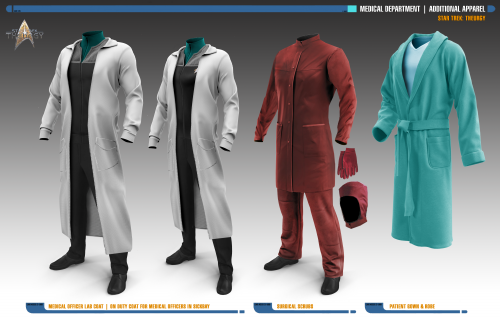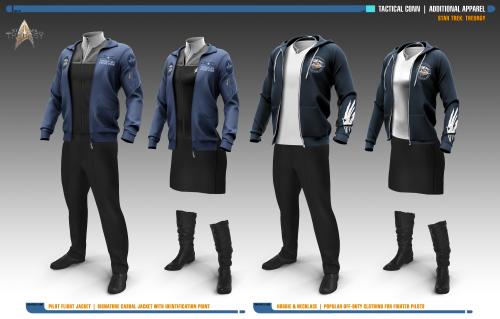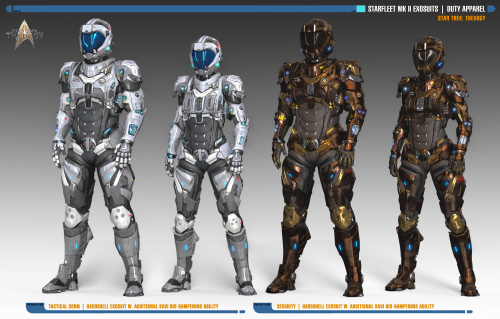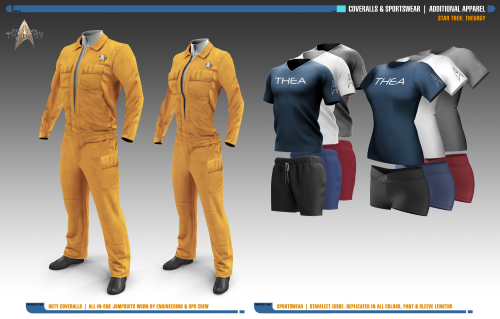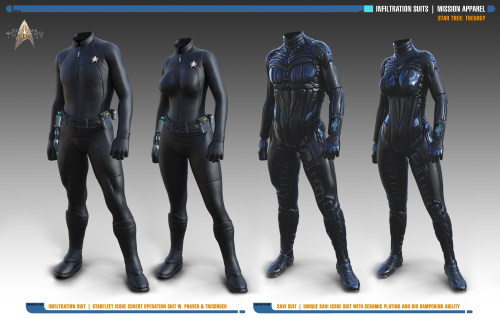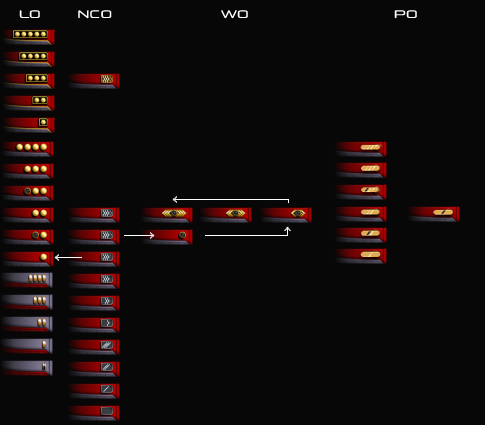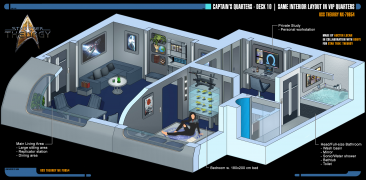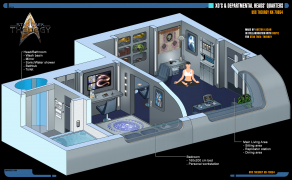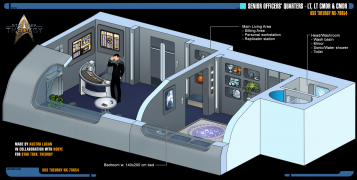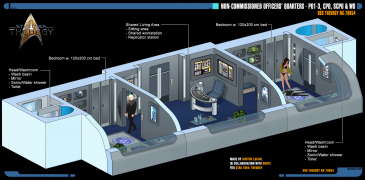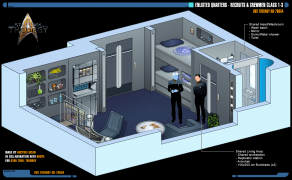Rank & Uniforms
From Star Trek: Theurgy Wiki
Starfleet ranks were the identifying titles for the officers and enlisted members of Starfleet, under both United Earth and the United Federation of Planets. These ranks used the titles and positions adopted from earlier Earth naval forces. Aside from rank, all officers also held a position in a department, which could be said to be his or her 'job'. Example: A Lieutenant's position was not to be a Lieutenant on a starship. The Lieutenant's position on a ship could Security Officer, which was a role that had certain duties attached to it.
Starfleet uniforms were mainly worn with colors denoting in what field a particular officer or crewman specialized.
Division Colors
Within Starfleet, there existed four divisions of personnel, which handled all possible allotted tasks.
Red indicated Command, Tactical and CONN. These were commanders, like COs and XOs, or administrative personnel, yeomen. They were also CONN and Flight Control officers. Tactical Officers also wore this colour, with the Chief Tactical Officer posted on the Bridge.
White indicated Tactical CONN. This was where the Starfleet Fighter Pilots and Officers belonged; in the newly formed Aerospace Command division where space aviation and military/tactical knowledge went hand in hand. The Tactical CONN department worked very closely with both the CONN and Tactical departments.
Gold indicated Engineering, Operations and Security. These were those who built, configured, alloted, and repaired ship's systems. Security handled security on board, ranging from crowd control, the Brig and a number of related issues.
Teal indicated Science, Medical and Counseling. These were the nurses, doctors, pharmacists, and orderlies of the Sickbay. They also analyse scientific data, and preform experiments.
Starfleet Uniforms
Starfleet uniforms were uniforms worn by individuals serving in the Federation Starfleet, originally a United Earth organization. These uniforms facilitated the wearers' needs as both scientists and researchers, as well as Starfleet's military role. Wearers were expected to abide by the Starfleet dress code, though special exceptions were sometimes made for certain aspects of an individual's cultural heritage, such as Worf's Klingon baldric and Nog's Ferengi headdress as well as Ro Laren's (and briefly Kira Nerys') earrings. Source: Memory Alpha
These were the Starfleet Uniforms as of 2381 in Starfleet. Like all ships, the USS Theurgy had a specific dress code for on-duty officers. The standard duty uniform was a three piece ensemble consisting of pants, colored undershirt (department specific color), and jacket. An optional skirt was permitted for female crew if they wished.
Rank
Ranks in Starfleet followed a specific order, broken up into four, in this descending rank:
- Flag Officers
- Commissioned Officers, including:
- Line Officers
- Cadets
- Warrant Officers
- Enlisted & Non-Commissioned Officers
Enlisted crewmen were not trained in any command fields, and fulfilled the mundane duties of a starship or starbase. Officers were trained for command, and it was assumed that some would someday reach the ranks of captain or above. Flag officers often fulfilled administrative duties, and sometimes commanded task forces of ships. Promotions were awarded for quality of service, not for length of time served.
Provisional Officers, the exception of the four above, earned a field promotion aboard a ship or a starbase, and could even hold Line Officer rank.
Flag Officers
A Flag Officer was both a historic naval and military rank and a modern Starfleet title. It generally referred to all officers of Commodore rank or higher. The term traditionally denoted any officer that commanded a squadron of vessels, possibly in addition to one under their direct command.
| Insignia | Rank | Information |
|---|---|---|
| Fleet Admiral | Fleet Admiral: Fleet Admiral was the highest rank in Starfleet. Fleet Admirals had many years of distinguished service and an impeccable record. There were only six Fleet Admirals: the Judge Advocate General, the Chief in Command, the Commander Starfleet, the Aerocorps Commander, the Director of the Corps of Engineers and the Fleet Commander.
Admiral: Admiral was the highest normal rank in Starfleet. Admirals had impeccable service records and decades of service. Flag Officers of Admiral rank were in command of all main divisions Starfleet with the exceptions listed above for Fleet Admirals. There were also eight sector Admirals who were responsible for operations in their specific area, such as the Romulan Neutral Zone or Home Sector. Vice Admiral: Vice Admirals were Flag Officers who had a specific mandate, such as a subsection of a Division, or an area of space. Vice Admirals also commanded task forces. Most Armadas and Task Forces were assigned to Vice Admirals. Rear Admiral: Rear Admirals were Flag Officers responsible for a limited and specific area for a limited time. Rear Admirals were usually promoted to Vice Admiral within two years. Rear Admirals could command major Starbases, Shipyards, Starfleet Bases on major worlds, or similar duties. Commodore: Commodore was a naval rank, the equivalent of which was used by the service organizations of many civilizations. As a traditional grade, commodore was the most junior flag officer rank of a naval organization, under an admiral rank (usually under rear admiral) but senior to a captain. Commodores commanded groups of ships, as opposed to captains commanding single ships or units. | |
| Admiral | ||
| Vice Admiral | ||
| Rear Admiral | ||
| Commodore |
Line Officers
A commissioned Line Officer was an individual who had attended, and graduated from the cadet program of Starfleet Academy or had been commissioned through the Officer Candidate School after having attained their education in their field elsewhere. Those graduating from Starfleet Academy earned a four-year degree (Bachelor's) in their major field of study such as communications, engineering, the sciences, or nursing. After four years at the Academy, they either passed or failed. If passing, the person would be promoted to Ensign. Officers doing exceptionally would be promoted directly to Lieutenant Junior Grade.
Medical officers attended an additional four years at Starfleet Medical Academy before earning their medical degree (or earned their commission through Officer Candidate School after having obtained their degree elsewhere).
| Insignia | Rank | Information |
|---|---|---|
| Captain | Captain: Captains were the most senior of line officers. Captains most often commanded Starships or Starbases of medium to large size. Captains could also command planetary outposts or serve as division heads for the Starfleet Bases on major worlds.
Commander: Commanders were senior line officers. Commanders usually served as the Executive Officer, Operations Officer, or Security Chief onboard a starship. Commanders could command small starships of under 100 crewmen, but this was rare. Commanders could also command small Starbases or minor outposts. Taking the Bridge Officer's Test was the only way for a Science or Medical Officer to be promoted to Commander, pending completion of the other requirements. Lieutenant Commander: Lieutenant Commanders were senior line officers. Lieutenant Commanders usually served as department heads aboard starship or on large Starbases. Lieutenant Commanders could be the Executive Officers on starships with a crew of less than 250, but usually Commanders filled that role. Lieutenant: Lieutenants were the most common line officers. Lieutenants could perform almost any Officer duty on a starship, save for being the Commanding or Executive Officer. In some cases Lieutenants could even be department heads, especially on smaller starships. Lieutenant Junior Grade: Lieutenants Junior Grade were junior Commissioned Officers. Lieutenants Junior Grade could be the Medical Officer or Science Officer on a mid to large space station, or man a Bridge Station. Officers typically spent around two years as a Lieutenant Junior Grade. Ensign: Ensigns were the most junior of line officers. Ensigns often served as Flight Controller aboard starships, or Operations Officer on small Starships. Ensigns could also serve in relief or assistant capacities to most other positions aboard ship. It was rare, but not unheard of, for a Cadet at Starfleet Academy to be granted a temporary commission of Ensign. This was only done in cases of truly outstanding grades. Officers typically spent around three years as an Ensign. | |
| Commander | ||
| Lieutenant Commander | ||
| Lieutenant | ||
| Lieutenant Junior Grade | ||
| Ensign |
Cadets
Cadet was a rank which was used at Starfleet Academy to denote students in training to become Starfleet officers. Becoming a Starfleet cadet was a difficult process and required a significant amount of academic achievement while in high school. Academy entrance standards were particularly high, especially in scientific and math disciplines (such as calculus). Cadets were also expected to maintain a satisfactory grade point average during their attendance at the Academy. Getting bad grades was grounds for a cadet's revocation of appointment from the Academy, also known as "washing out". Starfleet cadets were under the same uniform code of justice as Starfleet officers and were in turn subordinate to the orders of superiors. They were also required to report violations of Federation law they observed to their superiors. Cadets were also expected to show military courtesy and respect to senior commanders.
| Insignia | Rank | Information |
|---|---|---|
| Cadet 4th year | Cadet 4th year: Cadet 4th year were Cadets in their final year at Starfleet Academy. They had a leadership role in the Cadet Corps. Cadet's 4th year usually had at least one training cruise behind them. A Cadet 4th year could lead a Cadet Flight Squadron or special Cadet Operations Squad.
Cadet 3rd year: Cadet 3rd year were Cadets in their third year. In their third year at the Academy, Cadets underwent advanced training in their field as well as detailed instruction on the current state of the Galaxy. Cadets 3rd year could elect to take a training cruise in place of a class in Starfleet Operations. These cruises lasted between 4 and 16 weeks and gave Cadets real space experience. Cadet 2rd year: Cadet 2nd year were Cadets in their second year. In their second year at the Academy, Cadets participated in field duty. A Cadet could be posted in a training role to a Starship or Starbase, or could be lucky enough to earn membership in a Cadet Squadron or Cadet Operations Squad. Cadet 1st year: Cadet 1st year were the lowest level of Cadet. They were 1st year students with no seniority or special privileges. Cadet's 4th Class underwent what were certainly the worst conditions in Starfleet. 1st year Cadets endured cramped barracks, very intensive physical conditioning, and difficult classes. The ordeal almost always produced a hardworking, dedicated Cadet. | |
| Cadet 3rd year | ||
| Cadet 2nd year | ||
| Cadet 1st year |
Warrant Officers
Even though Warrant Officers were considered Commissioned Officers, they are drawn from the ranks of NCO personnel. The Warrant Officer, and the ranks that follow it, were a special form of Commissioned Officers bridging the gap between Enlisted personnel and Line Officers. Only Chief, Senior Chief, or Master Chief Petty Officers could apply to the Warrant Officer ranks. A warrant officer had rank over all Enlisted personnel, and frequently took charge of large divisions or departments of these crewmen. Regular commissioned officers, such as an Ensign, held rank over a Warrant Officer. SCPO or higher was able to advance directly to WO (skipping other ranks) provided they attended Officer Candidate School. Warrant Officers were specialists in sub-departments of a starship, such as Transporter Technicians and Holo-technicians.
Enlisted & Non-Commissioned Officers
Most of a starship's or starbase's staff consisted of enlisted personnel. These people carried out the day-to-day operations and maintenance that allowred Starfleet to function. Enlisted stayed in Starfleet Boot Camp for six months as a Crewman Recruit, learning the ropes in a more simple way than Commissioned Officers, with a course emphasis relevant to your division. So, Enlisted were those who had not completed the four-year Starfleet Academy course or otherwise been given a commission as an officer. In most cases, Enlisted crewmen signed up directly to a ship or posting, and received basic training, as well as any specific courses required for their position.
As with Commissioned Officers, there is a rank structure amongst Enlisted crew. The term "Non-Commissioned Officer" referred specifically to any Enlisted personnel given authority over other personnel. In Starfleet, this could refer to any Petty Officer (up to Master Chief). Once making the rank of Chief Petty Officer, NCOs could transfer to Commissioned Officer status, and become an Ensign.
All Commissioned Officer ranks, from Ensign upward, outranked all Enlisted in the chain of command. However, in certain cases, Non-Commissioned officers could exercise authority over Commissioned Officers (Miles O'Brien is one such case, in his position as chief of operations aboard Deep Space 9). Additionally, Chief Petty Officers such as O'Brien wielded influence far beyond their place in the rank structure due to their extensive experience and skill and were expected to mentor Junior Officers as well as other Non-Commissioned Officers.
| Insignia | Rank | Information |
|---|---|---|
| Master Chief Petty Officer | Master Chief Petty Officer: The Master Chief had usually served with distinction for many years. A handful of Master Chiefs served within Starfleet, all acknowledged leaders in their fields and commanding the respect of those beneath them. Such NCOs oversaw important departments and could enjoy treatment almost like that of a distinguished officer.
Senior Chief Petty Officer: Much like the Chief Petty Officer, the Senior Chief oversaw departments of large numbers of Enlisted personnel. Senior Chief Petty Officers were few in number, had served in Starfleet for a long time, and were experts in their field. A senior chief could be viewed as the Enlisted equivalent of a Commander. Chief Petty Officer: The Chief Petty Officers (CPO) oversaw large groups of Petty Officers and departments underneath him. These NCOs typically had many years of service (usually over 15) and a wealth of experience in their field. When one became "chief" he garnered a measure of respect for his accomplishments and proficiency. CPOs were sought out for their knowledge and experience. A Chief Petty Officer could command a major engineering or services department on a starship or starbase. Examples included the Transporter Chief of a Starship or the Chief of Operations of a Starbase. Petty Officer: There were three ranks of Petty Officer: 3rd, 2nd and 1st Class. A petty officer was not be confused with a Commissioned Officer in Starfleet, such as a Lieutenant. The term Petty Officer still refered to an Enlisted person. They were promoted from crewmen to 3rd Class, then 2nd, and then 1st. Petty Officers were referred to as Non-Commissioned Officers, or NCOs, because they frequently oversaw several Enlisted crewmen in their departments, and were trained to do so. Most Petty Officers reported to a Chief Petty Officer or sometimes a Commissioned Officer. A Petty Officer underwent more rigorous training, or was risen from the Enlisted ranks to his current position. Crewman 1st Class: Similar to a Crewmen 2nd Class, these crewmen were given slightly more responsibility and were more knowledgeable in their fields. Crewmen did not oversee any other Enlisted personnel and reported to Petty Officers above them. They were Enlisted personnel who usually had between 2 and 4 years of experience. Crewman 2nd Class: These crewmen could also be referred to as "Specialist". The crewman was overseen by Petty Officers and had limited duties, usually seeing to a specific system or area of function. Crewmen 2nd Class were Enlisted personnel with typically less than 2 years of service. Promotion to Crewman 1st Class after 18 months of service was routine. Crewman 3rd Class: The lowest rank of the Enlisted personnel was Crewman 3rd Class. Upon graduating Starfleet Boot Camp, all Enlisted personnel held this rank. Recruit: Recruits were only found within Starfleet Boot Camp while personnel underwent training. Upon completion of the year-long training program, they received an automatic promotion to the rank of Crewman 3rd Class, and in some cases could quickly distinguish themselves and attain the rank of Crewman 2nd Class straight out of Boot Camp. | |
| Senior Chief Petty Officer | ||
| Chief Petty Officer | ||
| Petty Officer 1st Class | ||
| Petty Officer 2rd Class | ||
| Petty Officer 3rd Class | ||
| Crewman 1st Class | ||
| Crewman 2nd Class | ||
| Crewman 3rd Class | ||
| Crewman Recruit |
Provisional Officers
In difficult times, it had been found a necessity to grant civilians - or crew members of other militaries - ranks that would otherwise be considered official within Starfleet. These ranks could be placed upon those that allied to Starfleet in some form or manner for whatever reason that the Commanding Officer of the ship found adequate. Provisional Officers had special rank insignia that differed from the normal pips that a Starfleet Officer would wear in his collar (Example: The rank insignia the former Marquis officers wore in Star Trek: Voyager).
| Insignia | Rank | Information |
|---|---|---|
| Captain | See tables above for Line Officers and Warrant Officers. The provisional equivalent of the ranks should not have been considered else than what they would usually entailed. This, since the provisional promotion was enforced by the Captain of a starship or starbase. In reality, there might have been social friction and misunderstandings about this, but officially, there was no difference from the regular ranks. | |
| Commander | ||
| Lieutenant Commander | ||
| Lieutenant | ||
| Lieutenant Junior Grade | ||
| Ensign | ||
| Chief Warrant Officer 1st Class | ||
| Chief Warrant Officer 2nd Class | ||
| Chief Warrant Officer 3rd Class | ||
| Warrant Officer |
Civillian Personnel
Not all members of the crew held a Starfleet rank, but would rather be civilian expertise in certain fields, filling functions of the ship where Starfleet training was not required. Examples: Waitresses/waiters of the ship lounges and the Chef in the Mess Hall. Also, some professors and scientists in certain fields did not belong to the Science Department of Starfleet.
Chain of Command
The chain of command was a ranking system used by militaries and other organized groups. It represented the line of authority down which orders are passed from one officer to another, and also the line down which passed command of a particular vessel or installation.
Aboard a starship, or most starbases the chain of command began with the assigned commanding officer, usually an officer of the rank of captain, or in some cases commander. If the commanding officer, for any reason, was unavailable to command his or her post then those responsibilities passed down the "chain" to the first officer, then the second officer, etc. After the first officer (also Executive Officer or XO), command responsibilities passed down the chain from officer to officer as necessary in accordance with each officer's rank. And it was common practice for a commanding officer to designate a second officer to take command if both the captain and first officer were unavailable or unable to perform their duties.
Crew Quarters
Rank also determined which kind of quarters Starfleet officers lived in aboard a starship. Below are the different quarters on the USS Theurgy.
Disclaimer
Uniform text portions of this page is used with permission of USS Wolff CO - granted Nov 1, 2016

